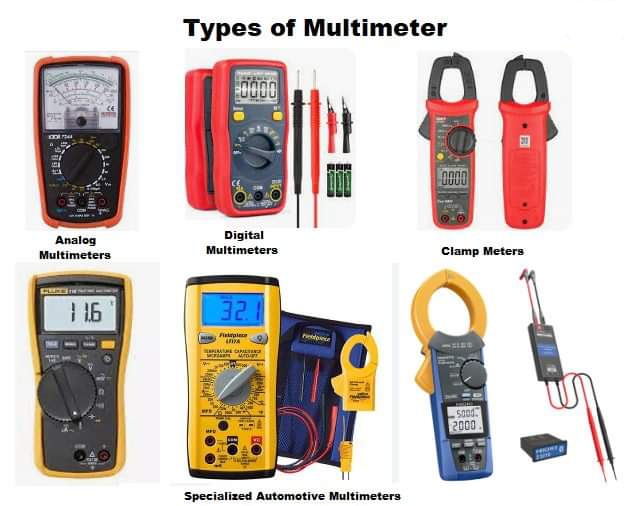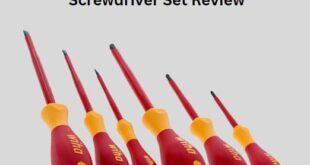Multimeter Types and Their Applications
Introduction
Multimeters are indispensable tools used in various fields that involve electrical measurements. They play a vital role in diagnosing electrical problems, troubleshooting circuits, and ensuring accurate measurements of voltage, current, resistance, and other electrical parameters. Understanding the different types of multimeters and their applications is essential for selecting the right tool for specific measurement needs.
In this guide, we will explore the world of multimeters and delve into their types and applications. We will discuss analog multimeters, digital multimeters (DMMs), clamp meters, and specialized multimeters, highlighting their unique features and measurement capabilities. By examining these different multimeter types, we can gain insights into how they are utilized in real-world scenarios and the advantages they offer for specific applications.
Whether you are a professional electrician, an electronics enthusiast, or simply someone interested in understanding electrical measurements, this guide will provide valuable information on multimeter types and their practical applications. Let’s embark on this journey to explore the fascinating world of multimeters and discover how they contribute to accurate electrical measurements in a wide range of industries and disciplines.

Analog Multimeters
Explanation of analog multimeters
- Analog multimeters use a moving pointer or needle on a scale to indicate measurements.
- They rely on analog mechanisms, such as a sensitive galvanometer, to measure electrical quantities.
Components and features
- Dial or scale: Displays measurement values across different ranges (e.g., voltage, current, resistance).
- Needle or pointer: Moves along the scale to indicate the measured value.
- Selector switch: Allows users to choose the desired measurement function (e.g., voltage, current, resistance).
- Range switch: Adjusts the sensitivity or measurement range based on the magnitude of the electrical quantity being measured.
- Test leads: Connect the multimeter to the circuit or component being measured.
Measurement ranges and capabilities
- Voltage: Analog multimeters can measure AC and DC voltages within a specified range, typically up to a few hundred volts.
- Current: They can measure current in milliamperes or amperes, with ranges typically up to a few amperes.
- Resistance: Analog multimeters can measure resistance in ohms with ranges typically up to a few megaohms.
- Continuity: Some analog multimeters have a continuity test function that checks for circuit continuity or broken connections.
Applications and use cases
- General electrical measurements: Analog multimeters are suitable for basic electrical measurements in residential, educational, and hobbyist settings.
- Circuit troubleshooting: They can help identify open circuits, measure voltage drops, and test component resistances.
- Simple electronics projects: Analog multimeters are useful for basic electronics projects that involve voltage, current, or resistance measurements.
Advantages and disadvantages
- Advantages: a. Simple and intuitive to use, especially for beginners. b. Can measure rapidly changing values, as the needle responds in real-time. c. Does not require batteries or power source for operation.
- Disadvantages: a. Less precise and accurate compared to digital multimeters. b. Reading errors and parallax issues may occur due to the position of the observer. c. Limited measurement range and lower resolution compared to digital multimeters. d. Susceptible to electrical noise and interference.
Digital Multimeters (DMMs)
Explanation of digital multimeters
- Digital multimeters (DMMs) are electronic devices that use digital displays to present measurement readings accurately.
- They convert analog electrical signals into digital data for precise measurements and offer additional features compared to analog multimeters.
Components and features
- Digital display: Shows measurement values numerically, often with additional symbols and units.
- Selector dial or buttons: Allows users to choose the desired measurement function and range.
- Input jacks: Connect the test leads for different measurement types (voltage, current, resistance, etc.).
- Mode buttons: Provide additional functions like capacitance, frequency, temperature, and diode testing.
- Auto-ranging: Automatically selects the appropriate measurement range based on the detected signal.
Measurement ranges and capabilities
- Voltage: DMMs can measure both AC and DC voltage, typically ranging from millivolts to kilovolts.
- Current: They can measure both AC and DC current, ranging from microamps to several amperes.
- Resistance: DMMs can measure resistance from milliohms to megaohms.
- Additional measurements: Many DMMs offer capacitance, frequency, temperature, and diode testing functions.
Applications and use cases
- Electrical troubleshooting: DMMs are essential for diagnosing and troubleshooting electrical circuits and components.
- Electronics and electrical engineering: DMMs are used for testing and verifying electronic circuits, PCBs, and components.
- Industrial maintenance: They help in preventive maintenance, equipment testing, and identifying faulty connections.
- Automotive diagnostics: DMMs are valuable for measuring voltages and currents in vehicle electrical systems.
Advantages and disadvantages
- Advantages: a. High accuracy and precision, offering more reliable measurements. b. Wide measurement range and various additional functions. c. Digital displays eliminate parallax errors and provide clear readings. d. Some DMMs offer data logging and connectivity options for data analysis.
- Disadvantages: a. Higher cost compared to analog multimeters. b. Slower response time compared to analog meters for rapidly changing signals. c. Requires batteries or external power source for operation.
Understanding the capabilities, features, and pros and cons of digital multimeters helps users make informed decisions when selecting the appropriate tool for their electrical measurement needs.
Clamp Meters
Explanation of clamp meters
- Clamp meters are specialized multimeters that can measure electrical current without breaking the circuit.
- They use a built-in current clamp or current transformer to detect the magnetic field generated by current flow.
Components and features
- Current clamp: A hinged jaw-like structure that can be clamped around a conductor to measure current.
- Digital display: Shows measurement readings and additional information.
- Selector dial or buttons: Allows users to select the measurement function (current, voltage, resistance).
- Test leads: Used for voltage, resistance, and other measurements besides current.
- Range selection: Allows users to choose the appropriate measurement range.
Measurement ranges and capabilities
- Current: Clamp meters can measure both AC and DC current, ranging from milliamperes to hundreds or thousands of amperes.
- Voltage: Some clamp meters also offer voltage measurement capabilities within a specified range.
- Resistance: Many clamp meters can measure resistance, but the range is typically limited.
Applications and use cases
- Electrical troubleshooting: Clamp meters are ideal for quickly measuring current in live wires without disconnecting them.
- HVAC systems: They are useful for measuring current in HVAC equipment, such as motors and compressors.
- Power monitoring: Clamp meters can assess current flow and power consumption in residential or commercial settings.
- Automotive diagnostics: They help measure current in automotive circuits, such as battery and charging systems.
Advantages and disadvantages
- Advantages: a. Non-invasive current measurement without interrupting the circuit. b. Convenient for measuring large currents or in tight spaces. c. Suitable for both AC and DC current measurements.
- Disadvantages: a. Limited measurement range compared to other multimeters for voltage and resistance. b. Less precise compared to dedicated current measurement devices. c. Can be sensitive to positioning and magnetic interference.
Understanding the features, capabilities, and pros and cons of clamp meters enables users to make informed decisions about when and where to utilize them for efficient current measurements without the need for circuit interruption.
Specialized Multimeters
Explanation of specialized multimeters (e.g., automotive, HVAC)
- Specialized multimeters are designed for specific industries or applications, catering to unique measurement requirements.
- Examples include automotive multimeters, HVAC multimeters, and other specialized variants.
Components and features
- Specific measurement functions: Specialized multimeters may have dedicated measurement modes tailored to the industry or application they serve.
- Additional features: They often incorporate specialized features like temperature measurement, duty cycle measurement, and specific unit conversions.
- Test leads and probes: Similar to standard multimeters, specialized variants include appropriate test leads and probes for specific measurement needs.
Measurement ranges and capabilities
- Automotive multimeters: These multimeters are designed for automotive diagnostics and typically include features for measuring automotive-specific electrical parameters, such as RPM, dwell angle, and duty cycle. They may also have functions for testing sensors, circuits, and ignition systems.
- HVAC multimeters: HVAC-specific multimeters offer features for measuring parameters related to heating, ventilation, and air conditioning systems. They may include functions for measuring temperature, humidity, airflow, and capacitance. Some HVAC multimeters also provide built-in thermocouple compatibility.
- Other specialized multimeters: There are multimeters tailored for specific industries or applications, such as industrial maintenance, telecommunications, or laboratory use. These variants may offer specialized measurement capabilities, such as high-frequency measurements or advanced data logging features.
Applications and use cases
- Automotive diagnostics: Automotive multimeters are valuable tools for diagnosing electrical issues in vehicles, testing sensors, and troubleshooting electrical circuits in automotive systems.
- HVAC systems: HVAC multimeters are essential for measuring and troubleshooting electrical parameters in heating, ventilation, and air conditioning systems, including temperature, airflow, and capacitance.
- Industry-specific applications: Specialized multimeters find applications in various industries, such as industrial maintenance, telecommunications, laboratory research, where specific measurement capabilities are required for specialized equipment or systems.
Specialized multimeters cater to the specific needs of various industries and applications, offering tailored features and measurement functions. By utilizing these tools, professionals can effectively carry out industry-specific measurements and diagnostics.
Choosing the Right Multimeter
Factors to consider when selecting a multimeter
- Measurement requirements: Determine the specific electrical parameters you need to measure, such as voltage, current, resistance, capacitance, or frequency.
- Measurement range: Consider the range of values you anticipate measuring to ensure the multimeter can handle the required measurements accurately.
- Accuracy and precision: Assess the multimeter’s accuracy specifications and resolution to ensure they meet your measurement needs.
- Ease of use: Consider the user interface, display readability, and ease of operation to ensure comfortable and efficient usage.
- Build quality and durability: Look for a multimeter that is well-built, durable, and suitable for the environments or conditions in which it will be used.
Considerations for different applications and measurement needs
- Industry or application-specific requirements: Determine if there are any specific features or measurement capabilities necessary for your industry or application, such as automotive diagnostics, HVAC systems, or laboratory research.
- Additional functions: Assess if you require extra features like temperature measurement, diode testing, data logging, or connectivity options.
- Specialized probes and accessories: Consider the availability of compatible probes and accessories that may be required for specific measurements or applications.
Safety features and certifications to look for
- Overload protection: Ensure the multimeter has built-in protection mechanisms to prevent damage in case of excessive voltage or current.
- CAT safety ratings: Look for multimeters that comply with the appropriate safety categories (CAT I, CAT II, CAT III, CAT IV) based on the intended usage and the electrical environment.
- Safety certifications: Check if the multimeter holds relevant safety certifications from reputable organizations, such as UL (Underwriters Laboratories) or CSA (Canadian Standards Association).
Budget considerations
- Determine your budget range: Establish a budget for the multimeter purchase, considering your requirements and the quality needed for your intended use.
- Balance cost and features: Evaluate the features and capabilities of different multimeters within your budget range to find the best value for your specific needs.
By considering factors such as measurement requirements, application considerations, safety features, and budget constraints, you can make an informed decision when selecting a multimeter that suits your specific measurement needs.
Tips for Proper Use and Maintenance
Safety precautions while using a multimeter
- Familiarize yourself with the multimeter’s user manual and safety instructions before use.
- Use appropriate personal protective equipment (PPE), such as safety goggles and insulated gloves, when working with high voltages or currents.
- Ensure the multimeter’s selector switch is set to the correct measurement function and range.
- Always start with the highest range setting and gradually decrease it to obtain the most accurate measurement.
- Never exceed the multimeter’s maximum voltage, current, or resistance limits to avoid damage or injury.
- Avoid touching exposed conductive parts or live circuits while taking measurements.
- Disconnect power sources and discharge capacitors before connecting or disconnecting the multimeter.
Proper handling and storage guidelines
- Handle the multimeter with care, avoiding unnecessary drops, impacts, or exposure to extreme temperatures or moisture.
- Store the multimeter in a clean and dry environment to prevent dust accumulation or moisture damage.
- Protect the multimeter’s display and probes with provided covers or cases when not in use.
- Coil and secure the test leads properly to prevent tangling or damage.
- Avoid storing the multimeter near strong electromagnetic fields, as it can interfere with its functionality.
Calibration and maintenance recommendations
- Periodically calibrate the multimeter according to the manufacturer’s guidelines or industry standards to ensure accurate measurements.
- If calibration is necessary, consult professional calibration services or follow the recommended procedures outlined in the user manual.
- Regularly inspect the test leads for signs of wear or damage, such as fraying insulation or loose connections, and replace them if needed.
- Clean the multimeter’s contacts, probes, and connectors with appropriate cleaning solutions or a lint-free cloth to maintain proper electrical connections.
- Keep the multimeter’s firmware or software up to date, if applicable, to benefit from any performance or feature enhancements provided by the manufacturer.
Following these tips for proper use, handling, storage, and maintenance of your multimeter can help ensure accurate measurements, prolong its lifespan, and maintain safety during electrical testing and troubleshooting activities.
Real-life Examples
Practical examples showcasing the use of different multimeter types
Example 1: Analog Multimeter
- Measuring the voltage across a battery: An analog multimeter can be used to measure the voltage of a battery by connecting the test leads to the battery terminals and selecting the appropriate voltage range on the multimeter’s dial. The analog needle will indicate the voltage level on the display.
- Checking continuity in a circuit: Analog multimeters can be used to test for continuity by connecting the test leads across a circuit element or connection. If the analog needle deflects or there is an audible tone, it indicates a closed circuit.
Example 2: Digital Multimeter (DMM)
- Measuring AC/DC voltage: A digital multimeter can be used to measure AC or DC voltage in electrical circuits. By selecting the voltage function and range, connecting the test leads to the circuit, the digital display will show the precise voltage reading.
- Measuring resistance: DMMs can measure resistance in various components or circuits. By selecting the resistance function and range, the DMM can be used to determine the resistance of a resistor, a wire, or any other component.
Example 3: Clamp Meter
- Measuring current in a live wire: A clamp meter is ideal for measuring current in a live wire without disconnecting it. By clamping the jaws around the wire, the clamp meter will display the current flowing through it.
- Checking current draw in an appliance: A clamp meter can be used to measure the current draw of appliances. By clamping the jaws around the power cord or one of the conductors, the clamp meter will provide the current reading.
Example 4: Specialized Multimeters
- Automotive diagnostics: An automotive multimeter is invaluable for diagnosing electrical issues in vehicles. It can be used to measure voltages, currents, resistance, and perform specific tests like checking ignition systems or testing sensors.
- HVAC systems: An HVAC multimeter is essential for HVAC technicians. It can measure parameters like temperature, airflow, and capacitance, enabling them to troubleshoot and maintain heating, ventilation, and air conditioning systems.
These real-life examples demonstrate how different types of multimeters are used in various scenarios for electrical measurements, diagnostics, and troubleshooting. Each type of multimeter offers unique capabilities that cater to specific measurement needs, making them indispensable tools in different industries and applications.
FAQs
What are the different types of multimeter?
The different types of multimeters include analog multimeters, digital multimeters (DMMs), clamp meters, and specialized multimeters for specific industries or applications.
What is the application of analog multimeter?
Analog multimeters are used to measure voltage, current, and resistance in electrical circuits. They are commonly used in educational settings, basic electrical troubleshooting, and for simple measurements.
What are the three applications of digital multimeter?
The three applications of digital multimeters (DMMs) include measuring voltage, current, and resistance in electrical circuits. DMMs offer precise digital readings and additional functions such as capacitance measurement, diode testing, and temperature measurement.
What is the definition and application of multimeter?
A multimeter is a versatile electronic instrument used to measure electrical parameters such as voltage, current, resistance, and continuity. Its application includes electrical testing, diagnostics, troubleshooting, and maintenance in various industries, including automotive, HVAC, electronics, and electrical engineering.
What is the most popular type of multimeter?
Digital multimeters (DMMs) are the most popular type of multimeters due to their accuracy, ease of use, and additional features. They provide precise digital readings and offer a wide range of measurement capabilities.
Is multimeter AC or DC?
Multimeters are designed to measure both AC (alternating current) and DC (direct current) electrical quantities. They have different settings and ranges for measuring AC and DC voltages, currents, and other parameters.
What is the principle of multimeter?
The principle of a multimeter is based on various electrical measurement principles, such as voltage dividers, current shunts, and resistance networks. These principles allow the multimeter to measure and display the electrical quantities accurately.
Why is it called a multimeter?
The term “multimeter” comes from the combination of “multi” (meaning multiple) and “meter” (indicating measurement). It is called a multimeter because it can measure multiple electrical parameters, such as voltage, current, resistance, and continuity, using a single instrument.
What is the difference between analog and digital multimeter?
The main difference between analog and digital multimeters lies in the way they display readings. Analog multimeters use a mechanical needle to indicate measurements on a scale, while digital multimeters provide precise digital readings on an LCD or LED display. Digital multimeters also offer additional features, such as auto-ranging, data hold, and connectivity options, which are not typically found in analog multimeters.
Conclusion
In conclusion, multimeters are versatile tools that play a crucial role in electrical measurements, diagnostics, and troubleshooting. They provide accurate readings of voltage, current, resistance, and other parameters, allowing professionals and enthusiasts to assess the health and performance of electrical systems and components.
We have explored different types of multimeters, including analog multimeters, digital multimeters (DMMs), clamp meters, and specialized multimeters. Each type has its own set of features, measurement capabilities, and applications. Analog multimeters offer simplicity and reliability, while DMMs provide precise digital readings and additional functions. Clamp meters allow non-invasive current measurements, and specialized multimeters cater to specific industries or applications.
Choosing the right multimeter involves considering factors such as measurement requirements, safety features, and budget constraints. It is important to follow safety precautions, handle and store the multimeter properly, and perform regular maintenance to ensure accurate measurements and prolong its lifespan.
Real-life examples have illustrated how different multimeter types are used in practical scenarios, from measuring voltage and current in circuits to diagnosing automotive or HVAC systems. These examples demonstrate the versatility and utility of multimeters in various industries and applications.
By understanding the different multimeter types, their features, and applications, individuals can make informed decisions when selecting the most suitable multimeter for their specific needs. Multimeters empower professionals, technicians, and enthusiasts to work with confidence, ensuring accurate electrical measurements and efficient troubleshooting.
 Electrical Engineering World Wiring a Brighter Tomorrow!
Electrical Engineering World Wiring a Brighter Tomorrow!



